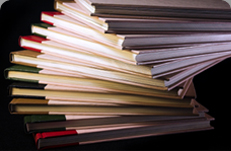|
|
 |
|
| | Presentation is Everything! |
|
|
Whether your print project is an emergent, short-order job to impress a client or it’s a novel with years in-the-making, your best efforts can fall short of your own expectations if the finished product is not presented in the best light. That’s where we come into the picture. | | | You don’t have to spend a fortune to get top-notch professional results. Technology has made the printing and binding process extremely precise and efficient. You might be surprised to learn that smaller, less established bindery companies actually must charge higher prices because they often work with less efficient, older technology which requires more manual involvement and less precision. | | | | | | | When your printed product looks good, you look good. And when you look good, we look good. Our success depends on the quality of your image, and we don’t take that responsibility lightly. | | | Use our technological advantage to save you money while ensuring the highest quality folding and binding. Ensure that your hard work will impress the toughest critics. Yes, they will judge your book by its cover. |
|
|
 |
| |
| | |
|
|
| Printing & Binding Questions and Answers | | | Q: Can you color-match my printed publication so it looks the same on paper as it does on my computer screen? | | | A: On your home computer, you may notice that when you print something, the paper copy sometimes looks different than what you saw on your screen. This is because computer screens combine three colors (Red, Green, & Blue) to display the color spectrum, while printers use four |
|
| |
|
| | |
colors (Cyan, Magenta, Yellow, & Black). Therefore these two methods, RGB and CMYK respectively, have variations in how they are displayed. Professional printers calibrate their computer displays to match the printed output, and often use a special process called the Pantone Color Matching System to ensure consistency between electronic and printed products. Bindery Workers Inc ensures that your final product is properly color matched. | | | Q: What the difference between matte and gloss paper stock, and which should I use for my publication? | | | A: Matte stock has a dull finish that is often used to make text-intensive pages easier to read, while gloss stock is coated with a shiny finish often used with color printing to make images more vivid on the page. The best stock to use for your project will depend on the content of the material you are printing as well as how your finished product will be used. The choice is obviously yours, but we can help you make the right decision. Give us a call to discuss your project. | | | Q: What is “binding” and what is involved with having my printed publication finished professionally? | | | A: “Binding” is the process of combining printed pages into finished products such as catalogs, books, magazines, etc. In order to bind a project once it has been printed, pages must be cut, folded and either glued, stitched or stapled using special machines. The best method for binding your project will vary based on the materials used and the number of pages. Please call us to discuss your publication and we can help you explore your options. | | | Q: Are there any special considerations that I should know about when finishing my printed work? | | | A: Yes, definitely. Many of them are determined by the type of finishing work used to bind your project. For example, a folded book that is center-stapled using tabloid-sized sheets will result in an 8½ x 11” finished product, but to bind the project using a center-stapled layout, your page count must be evenly divisible by four (4). You would also need to consider typesetting elements such as margins, gutters, bleeds, etc. before finalizing your printed publication. We specialize in the art of typesetting all kinds of documents for different purposes. Put our expertise to work for you by calling us today! |
|
| | |
| | |
| | |
|
| |